THE CONSERVATION OF A PAINTED BALTIMORE SIDECHAIR (ca. 1815) ATTRIBUTED TO JOHN AND HUGH FINLAY
PETER L. FODERA, KENNETH N. NEEDLEMAN, & JOHN L. VITAGLIANO
1 BACKGROUND
Maryland generated a great quantity of furniture in its classical period, about 1815–45. Its greatest furniture-making center was Baltimore, which produced numerous pieces typified by painted, neoclassically inspired forms. The most important makers of what has come to be known as Baltimore furniture were the brothers John and Hugh Finlay (Weidman 1993).
The Finlay brothers began manufacturing stylish, decorated furniture for a wealthy clientele prior to 1815, but it was their involvement with the noted English-trained architect Benjamin Henry Latrobe (1764–1820) in 1808–9 that laid an important part of the foundation upon which they would build their reputation as the leading furniture makers in the region. Latrobe had been commissioned by William Waln, a successful businessman in China trade, to design and oversee the construction and decoration of his new residence in Philadelphia. The completed interior was a confident interpretation of the Greco-Roman aesthetic, with careful attention given to every detail. Its palette was limited to the Etruscan red, yellow ochre, pale blue, and black employed in the English neoclassical designs popularized by Robert Adam and John Sloan. There was an emphasis on trompe l'oeil decoration, imitating architectural elements and appliqued materials in a stylized linear format. Latrobe referred to these techniques as the “Greek method of painting” and was struck by “the beauty of the construction and the relief produced by it” (quoted in Lindsey 1991, 212). While the Finlay brothers were responsible only for the construction of selected pieces of furniture for the Waln commission, they were no doubt influenced by the elegance of the neoclassical style as well as the concept of a total approach to household decoration in America. This idea was reinforced the following year, when Latrobe commissioned the brothers to execute a set of 36 chairs, two sofas, and four settees for the newly decorated drawing room of President James and Dolley Madison. Although the furniture was destroyed when the White House burned in the fire of 1814, drawings for it bearing Latrobe's instructions still exist (fig. 1).1 Once again, the forms were a reinterpretation of classical Greek and Roman designs, executed in a controlled palette. By 1810, Hugh Finlay was able to travel to Europe, where he had firsthand contact with Empire motifs, and the brothers quickly developed a familiarity and comfort with the neoclassical idiom sufficient to establish their preeminence in the field. They were virtually the only firm advertising painted classical furniture made en suite(Weidman 1993).
Fig. 1.
Benjamin Henry Latrobe, designs for a chair for the drawing room of the White House, Washington, D.C., 1809. Watercolor, pencil, pen, and ink on papter. Left and right illustrations 5� � 5⅝ in.; center plan view in 7� � 5� in. Maryland Historical Society, purchased from Mrs. Gamble Latrode
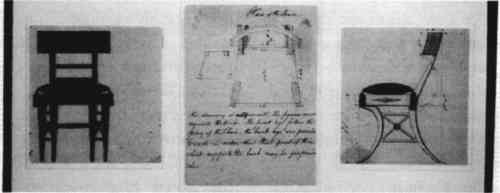 |
Although Latrobe was an important proponent of classically inspired designs, the forces that shaped early 19th-century American fashions are naturally much larger and more complex than any single individual or single source of designs. A number of design and pattern books served to promote the development of this aesthetic, which was often referred to as “Grecian style.” Notable among these are the books of Thomas Hope, Thomas Sheraton, and Charles Percier and Pierre Fran�ois L�onard Fontaine (fig. 2).
Fig. 2.
Illustration from Household Furniture and Interior Decoration, 1807, by Thomas Hope
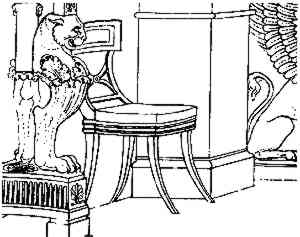 |
Figure 3 depicts a characteristic “Grecian” or “Empire” chair form known as a klismos chair, examples of which are found on ancient vases. Note the sloped back, wide crest rail, and saber legs. The strong influence of this Greek form on the furniture designs of the period was a natural consequence of the great revival of interest in classical ideas inspired by archaeology, and many chairs of the period reflect this interest. The sidechair in the Kaufman Americana Foundation Collection is depicted before treatment in figure 4. It is one of a set of 11 existing chairs that descended through the family of Arunah Shepherdson Abell and is thought to have been commissioned by Charles and Mary Ann Carroll of Litterluna, in Baltimore County (Weidman 1993). These chairs are generally considered to be the finest examples of painted Baltimore chairs. Others from the set are in the decorative arts collections of the Metropolitan Museum of Art, the Munson-Williams-Proctor Institute Museum of Art in Utica, the High Museum of Art in Atlanta, and the Baltimore Museum of Art.
Fig. 3.
Painter of Polygnotan Circle, Greek Attic pottery, ca. 430 B.C. Red figure vase ceramic, terracotta, 34.6 � 24.6 cm. Collection of the Harvard University Art Museums, 1960.34
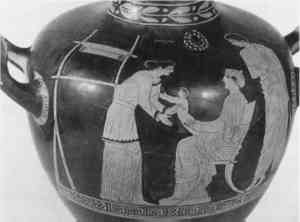 |
Fig. 4.
Kaufman chair before treatment
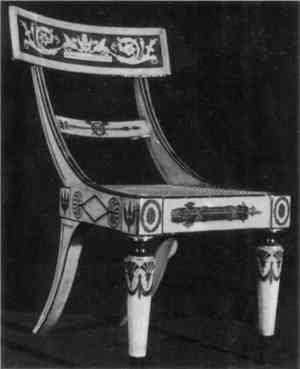 |
Unfortunately, much of the furniture produced by the prolific Finlay workshop was not signed and is poorly documented. However, many of the painted motifs on different pieces are identical in their placement and realization. On the basis of stylistic comparison of these chairs to other well-documented and recently discovered pieces, the scholar Gregory Weidman gives a very convincing argument for Finlay authorship. Stylistic comparison to a card table, also in the Kaufman Collection, suggests that they may have been part of the same suite (fig. 5). The table, which was made for John W. Stump, bears obvious affinities to our chair. Both share an identical color scheme, decorative elements, and elegant saber legs. The excellent condition of the Kaufman table provided us with important insight into the clarity and precision of the original Finlay design.2
Fig. 5.
Card table attributed to John and Hugh Filay, ca. 1815. Collection of Mr. and Mrs. George Kaufman
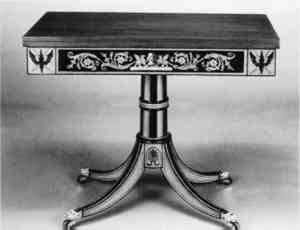 |
In 1965, the Metropolitan Museum of Art acquired 9 of the 11 known chairs from this probable set of 12 from a Baltimore dealer. Two more remained in private hands. Just two years prior to the Metropolitan's acquisition of the chairs, a landmark exhibition, Classical America, 1815–1845, opened at the Newark Museum. This ground-breaking exhibition was curated by William H. Gerdts and the late Berry B. Tracy, who was then curator of American decorative arts at the Newark Museum and subsequently a curator at the Metropolitan. Never before had so successful a case been made for the careful consideration of works created in this style (Lyle 1993). The acquisition of the chairs by the Metropolitan was very important, and Berry Tracy had them conserved in 1967. In 1972, two were traded to the Baltimore Museum (Elder and Stokes et al. 1987, 51). The institutions mentioned earlier and the Kaufman Americana Foundation each received one chair in separate arrangements, with the Kaufman Foundation acquiring its chair by exchange in 1994.
The chair had not been conserved since the 1967 treatment. While there is no existing documentation of the treatment, we ascertained from accession photographs that older restorations were not removed and that many of the earlier discolorations and damages remained until we began our treatment. The 1967 treatment seemed to address the integration of obvious losses. Cleaning was apparently minimal, and an extremely thick finish layer was applied to an already heavily loaded surface. For approximately 30 years, the chair and eight others from the set have been viewed in the context of that treatment, which was influenced by Berry Tracy's preference for highly finished surfaces without significant amounts of wear.3 It is important to note that the treatment of the chairs was performed by a conservator contracted by the museum, who answered only to the curator. This arrangement is a critical aspect of the historical context in which we feel the earlier treatment of these chairs must be viewed. Painted furniture has often fallen into an unfortunately gray category of object that is just now beginning to benefit from the cross-fertilization and maturation of the curatorial and conservation fields. This growth has promoted a more inclusive, collaborative approach, which relies on the various expertise of historians, conservators, conservation scientists, and owners. The reconsideration of the chairs' appearance, and the eventual treatment of the Kaufman chair, were prompted by the sharpened focus of interest in painted furniture that is a result of this vital trend.
|




